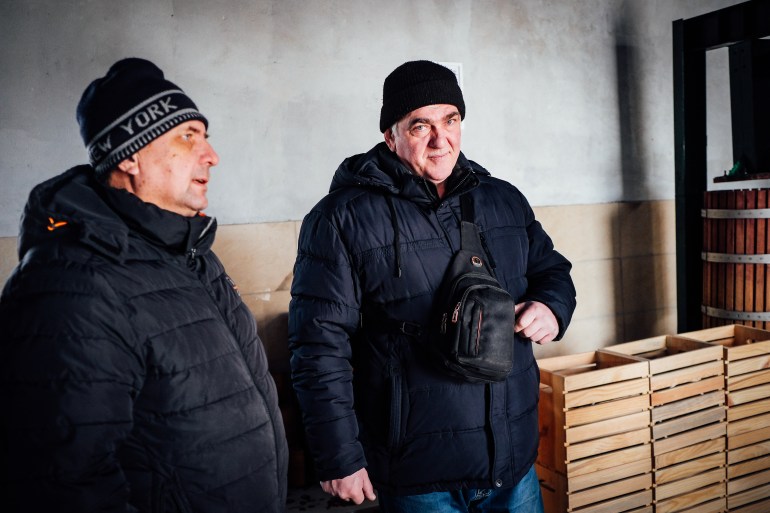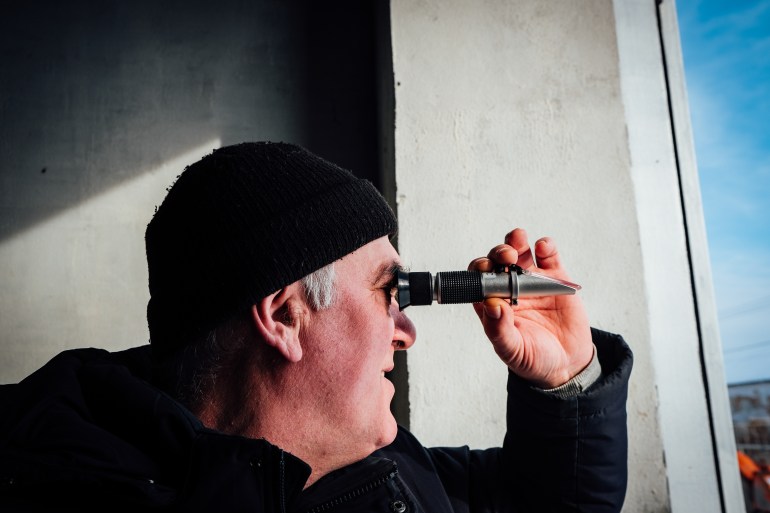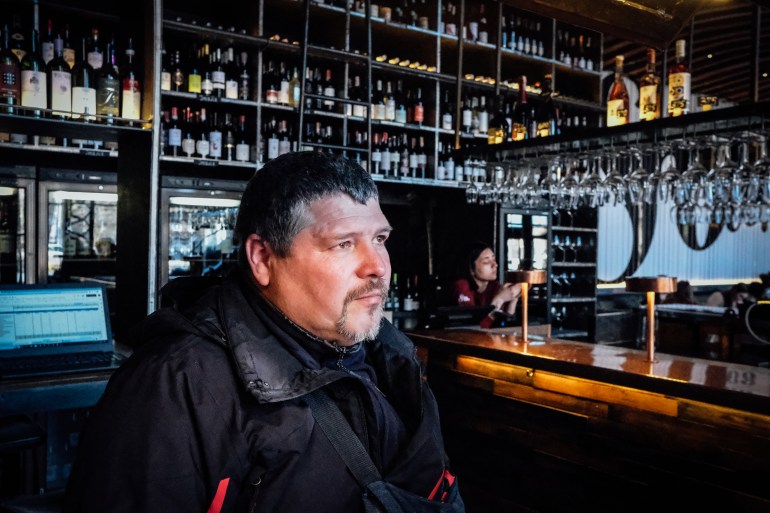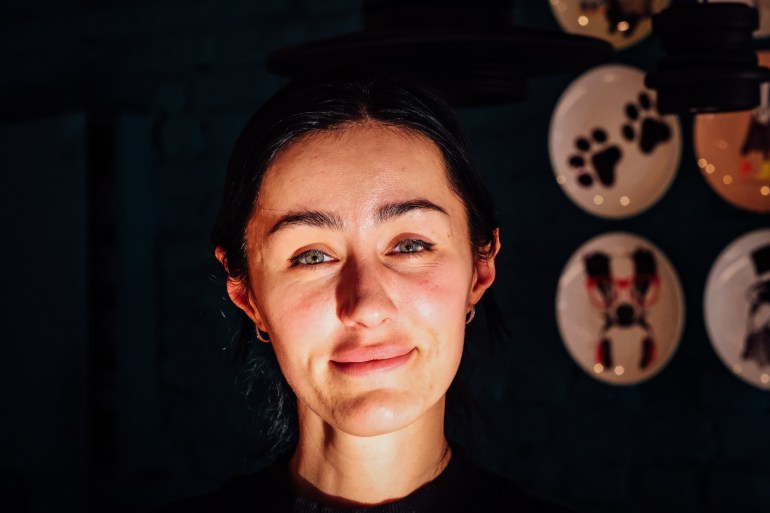Inside Ukraine’s wartime wine industry
Listen to this story:
Lviv and Kyiv, Ukraine – Roman Danyliak, a towering 55-year-old winemaker with white hair and weather-beaten skin, looks out over his six-hectare (645,800sq-foot) vineyard.
For a long time, he felt that Friend’s Winery, which he co-owns with his friend, Myron Zvozkii, nestled among the scenic undulating hills surrounding the city of Lviv in western Ukraine, had never been fully accepted by winemakers from the warmer climes of southern and eastern Ukraine more traditionally associated with winemaking.
Over the past decade, he says, warmer weather, which he attributes to climate change, had transformed the rich Ukrainian soil in his region into the perfect environment for growing fast-ripening grapes.
This change in climate had encouraged the pair to start a vineyard nine years ago and produce wine, a hobby they turned into a business four years later. In the west, there is now a burgeoning community of small-scale wineries. However, this had done little to raise the region’s profile in an industry reverential to reputation and tradition.
That was until February 24, 2022, when Russia launched a large-scale invasion of the country. “Before this date, the Ukraine wine community was very divided. Now, no one cares where you are from,” he says adamantly. “We are one big winemaking community.”
Since Russia invaded Ukraine, the traditional wine-making regions in the south and east of the country have found themselves on the front lines, with many wineries, such as Château Kurin near Kherson, a port city in southern Ukraine, falling into Russian hands. Others have been damaged by missile attacks, such as the Cassia family winery near Kyiv. The country’s largest bottle producer, Vetropack Gostomel in Kyiv, was also heavily damaged in February 2022.
However, despite the dangers of war, many winemakers have continued to operate, ensuring that the nascent Ukrainian wine industry, buoyed by growing demand, has continued to flourish. Wine lovers, in turn, spurred on by patriotism and sommeliers’ recommendations, are ditching foreign wines and opting for local producers.

Winemakers on the front line
“The Russian troops destroyed the vineyards around Kherson,” Danyliak says with a resigned shrug of his shoulders, adding that, when some of them were liberated, the owners found much of the stock had been looted.
Danyliak pulls out his phone to show a special digital credit card to which winemakers with a national association donate money on the same day every month. “This is for winemakers who are now fighting on the front line,” he says with pride in his voice. Several winemakers and sommeliers have reportedly been killed in fighting since the outbreak of the war.
The association of winemakers had recently gathered enough money to buy a camouflage military transport vehicle for the winemakers fighting around the front-line town of Mykolaiv in southern Ukraine. It lasted exactly one month before a volley of bullets rendered it useless. Danyliak says they will continue to raise money for combat gear and transport equipment and that sommeliers hold tasting sessions to donate the proceeds to the account.
In 2014, the Ukrainian wine industry lost 61,780 hectares (238.5sq miles) of vineyards – which were mainly for producing semi-sweet and dessert wines and made up roughly half the country’s production capacity – in Crimea after Russia annexed the Black Sea peninsula in a referendum rejected by the international community.

Danyliak says it was a major blow to a country rediscovering a wine-drinking culture that had largely disappeared during the Soviet period between 1922 and 1991.
He walks past two long wooden tables used to host wine-tasting sessions for tourists, squinting as he leaves the warehouse and heads into the blinding sunlight reflected off a fresh layer of snow. He points in an easterly direction to a city called Vynnyky – roughly 10km (6.2 miles) from central Lviv – which translates as wine. The name is a nod, he says, to the country’s historical connection to wine. “More than 100 years ago, there was lots of wine produced here,” he explains. “We had many different [indigenous] grapes we are rediscovering now – legend has it King Charles XII of Sweden would only drink Ukrainian wine.”
According to Danyliak, these wines disappeared for two reasons. One was colder weather that swept through the regions of Ukraine in the 20th century, ruining the climate for many of these grapes. The second was a lack of a competitive wine culture in the Soviet period when there was an emphasis on cheap vodka or wine produced in bulk.
“In the Soviet Union, people only used to consume vodka, people had less money and so bought what was cheap,” says Danyliak, who was 23 when Ukraine became an independent country in 1991. “But when the Soviet Union collapsed, people started travelling again, experiencing foreign wines.”

An image problem
In a swanky wine bar in central Lviv, 49-year-old winemaker Maksym Kychma sits hunched on a wooden stool. Behind him, Ukrainian wines, including bottles of merlot and cabernet sauvignon, line the countless wooden shelves. A waitress guides people to their tables, handing them a pamphlet that reads “proud of Ukrainian wine” and has a QR code for customers to place their order.
Kychma owns Yanchyn Hills, a small winery in the region that produces red, white and rosé wines. Like Danyliak, he struggled to convince customers that the Lviv region had the right climate for good wine. Since it wasn’t recognised as one of the southern winegrowing regions like Mykolaiv, Kherson and Odesa or Dnipro in central Ukraine, he could not apply for government subsidies. “Climate change simply moved faster than government legislation,” he says with a wry smile.
Ukrainian wines, in general, he says, have also suffered from an image problem. “There are a lot of preconceptions about Ukrainian wine, and until recently, many Ukrainians also thought a foreign wine would be better,” he explains. Kychma says this was partly caused by a tendency among Soviet-era wineries to value quantity over quality.
Viktoria Didur, a 22-year-old working at the bar behind him, agrees. “I have been a sommelier for three years now, but when I began, I had negative prejudgments of Ukrainian wine,” she says. She holds up her phone, which she had been frantically typing on a few moments earlier. “I’ve actually been holding a live Instagram session about Ukrainian wines and convincing people to overcome their preconceptions.”
The session, held in Ukrainian, had been filled with curious “people who wanted to support national winemakers after hearing that many of the vineyards in the south had been occupied or damaged”. However, they were unsure if Ukrainian wine, which many had considered a cheaper and less refined option, could be as good as foreign wines.
In response, she explained that there are many established Ukrainian wines on the international market and that the local market is eclectic, offering homegrown alternatives to well-known grape varieties like chardonnay or Riesling but also unique, experimental ones.

Growing ‘national self-esteem’
Didur says that since the war began, Ukrainians have been keen to support products made in Ukraine. When many vineyards were destroyed or occupied, sales of local wines in restaurants shot up. Before the war, wines from France, Italy and Georgia were the most popular. Now, she says, approximately 60 percent of the bar’s sales are Ukrainian wines.
Kychma explains that demand for Ukrainian wine was, in part, due to wartime restrictions on foreign wine imports which were not considered critical products and faced huge waits at the borders. The Ukrainian currency – the hryvnia, also fell in value, so many people switched to buying more affordable Ukrainian wine.
Still, he says the shift was largely driven by a growing “national self-esteem” which led people to opt for homegrown products, including wine. “We are now beginning to realise our worth,” he says firmly.
Vasyl Torskij, a 19-year-old with a ponytail, serves customers at a Lviv-based beer and wine shop. Outside, a new petrol-run generator sits idle, ready to kick in if a power cut sweeps through the area.
Torskij estimates that around four in every 10 customers buying wine will opt for Ukrainian wine compared with about two out of 10 before the war. He also says there is a sense that Ukrainian wine and local craft beer are in demand, a fact reflected in the noticeably snazzy labels.
War, he says, has changed the perception of these brands, which “now appear more attractive and innovative than many foreign brands and make young people want to buy local”.
Torskij picks up a bottle of Monte Cote, a red wine from the Zakarpattia region bordering Hungary, Slovakia and Romania in southwestern Ukraine that costs about $3. Its label has an abstract illustration of a cat surrounded by rolling hills and falling cherries. “This is my favourite,” he says, tapping the glass. “It’s got a clear and vivid taste.”
Anna Tkachuk, the 36-year-old bar manager of Artania Bar in the trendy neighbourhood of Podil in Kyiv, pulls off the pair of black disposable gloves she wore to cut cheese and takes out a bottle of semi-sweet red wine from a glass cabinet.
It is her favourite wine, Kara Kermen, named after a mythical fortress. It is produced by Beykush, located on the picturesque sun-beaten Beykush Bay by the Black Sea and known for its experimental varieties. Kara Kermen is a smoky, chocolatey wine made using a method in which grapes are air-dried to concentrate the flavour.
She pours a small amount into the wine glass and insists that I taste some. “A lot of foreigners did not know we had great Ukrainian wine,” she says.
Sasha Shmigelskaya, a 19-year-old waitress, explains that the Beykush vineyards are precariously close to the front line around Mikolaiv in southern Ukraine. “The 2022 and 2023 batches are already harvested under shelling and with missiles flying over the vineyards,” she says. “God hopes this will end soon and the winery can remain fully functional.”
The Kyiv-based bar closed on February 24, 2022, and only reopened this January. Since reopening, Tkachuk says she has already seen a considerable increase in people wanting to taste and buy Ukrainian wines.

Black wine
Anna Konstantina, a 36-year-old working at an upscale restaurant in Kyiv, politely guides customers to their tables. She is originally from the eastern city of Donetsk which was occupied in 2014 by Russian-backed separatists. She says ever since she was displaced nine years ago, promoting Ukrainian wine has been a source of “national pride”. Her home used to be located near a 250,000-sq-metre (2.7-million-square-foot) expanse of caves under Bakhmut – the front-line city now at the epicentre of months of bloody fighting – which contains hundreds of thousands of sparkling wines.
Now, she says people in Kyiv feel the same way she did and want to “support local brands”.
Oleksandr Liashenko, 35, a sommelier based in Kyiv, says that many of his colleagues have worked hard to “popularise Ukrainian wine” and reverse negative stereotypes over the years.
Liashenko, who has featured Ukrainian wines in his wine-tasting sessions, says this approach has succeeded partly because people appreciate the unique taste of some Ukrainian wines.
Ukrainian winemakers were trying to produce commercial products following the examples of French and Italian vineyards, using similar grapes and attempting to emulate the same tastes, but now wines are made with a particular local twist.
Liashenko gives the example of Kolonist, which he says is the country’s most popular winemaker, and produces a range he describes as “black wine”, created from a grape variety called Odesa black which was bred in the latter half of the 20th century. This red wine is often served at Ukrainian embassies worldwide, according to Liashenko.
Danyliak says that many tourists he has hosted at his vineyard have commented on the unique taste that emerges from the “black soil”, with some likening it to poppy flowers.

Resilient winemakers
Tkachuk says that the owner of Artania Bar has received many requests from European countries for Ukranian wine.
Before February 24, 2022, Ukraine imported $164m worth of wine but only exported $10.6m. Moreover, about 20 percent of those exports were to neighbouring Belarus, a country used as a staging post for Russia’s attempt to take Kyiv in the early months of the war and no longer trading with Ukraine.
Liashenko says that foreigners are often surprised to learn that the Odesa region is on roughly the same geographical latitude as Bordeaux in France or winegrowing regions in northern Italy such as Piedmont, meaning that Ukraine enjoys similar climate conditions for growing ideal wine-making grapes.
Tkachuk believes that demand will soon follow if people can taste Ukrainian wine abroad. “We have the perfect climate here with especially fertile land and unique grapes,” she says with pride in her voice.
Konstantina agrees. She pulls at a worn piece of metal – part of the last batch produced at the Azovstal steelworks before the full-scale invasion – attached to a string bracelet on her wrist. The steelworks had become the last holdout for Ukrainian forces protecting the southern port city of Mariupol and had become a symbol of Ukrainian bravery. Her bracelet is a symbol of that perseverance. Ukrainian winemakers will show a similar resilience, she explains, fiddling with her bracelet.
For Tkachuk, nothing can stop the Ukrainian wine industry, which has already lost so much land since 2014. “Even if Russia continues to occupy the vineyards, with our rich soil, we will just continue to grow new ones,” she says matter-of-factly.




